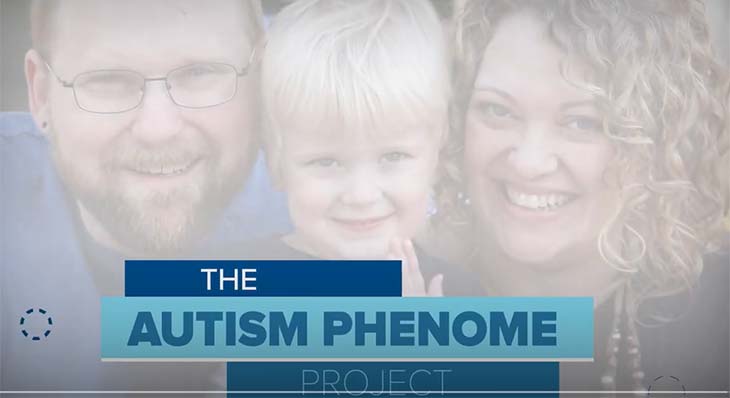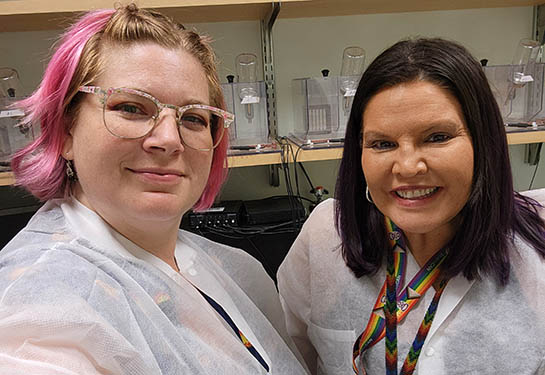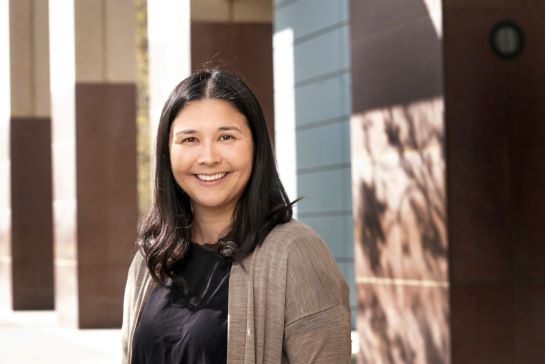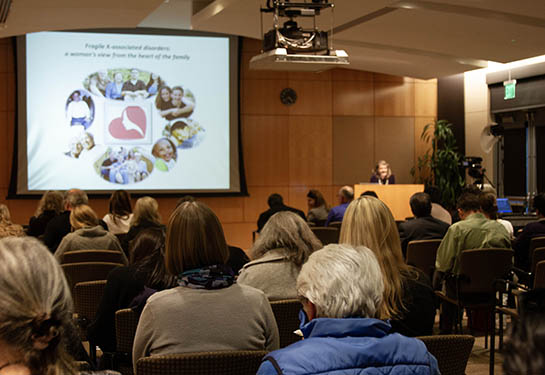Autism characteristics can change significantly from ages 3 to 11
A recent study by UC Davis MIND Institute researchers found that the severity of a child’s autism symptoms can change significantly between the ages of 3 and 11. The study was published in Autism Research, and built on previous work by the same researchers on changes to autism characteristics in early childhood. The children studied were all part of the MIND Institute’s long-term Autism Phenome Project (APP).
David G. Amaral, UC Davis distinguished professor, Beneto Foundation Endowed Chair and senior author on the papers, and Einat Waizbard-Bartov, graduate researcher and first author on the papers, answer questions about what they’ve learned so far. In the following Q&A, they provide details and context to help make sense of their findings.
Note: The authors recognize that medical terms such as “symptom” and “severity” are pathologizing and are making efforts to move away from this historical terminology. In this paper, the analysis is based on the “calibrated severity score” generated from the use of the diagnostic test the ADOS-2, which is why they’re using them in this instance.
You first studied whether a child’s autism symptoms changed from ages 3 to 6 – then expanded that in this most recent study to age 11. What did you find?
Waizbard-Bartov: In our first study, published in 2020, we looked at symptom severity change only during early childhood. Then, because the APP is a longitudinal, or long-term study, we were able to extend our observations all the way up to age 11. When we started this process, we thought that symptom severity remained stable across time, based on several previously published studies. But what we saw, surprisingly, is that about half of the kids changed significantly in early childhood; they either increased or decreased in terms of the severity of symptoms. When we extended the study to middle childhood, we found basically the same. In fact, a slightly higher percentage of kids’ symptoms changed into middle childhood.
Amaral - Based on the literature, the notion was that however severe you were at diagnosis, that’s how you’d be for the rest of your life. These two studies showed that’s not necessarily the case.
How did you measure symptom severity and trajectory?
Amaral: We used a well-established, objective measure called the ADOS [Autism Diagnostic Observation Schedule]. It is a clinician-administered test that involves observation of a child carrying out different behaviors. It’s the best possible measure for looking at severity across time. The children are clinically evaluated at different ages across time for social interaction, communication and other behaviors. The ADOS provides a score called the Calibrated Severity Score which allows comparison across ages and in children with different levels of challenges.
To understand autism, you can’t simply take a snapshot at any one point in time. Just like children develop over time, the features of autism also develop and change over time.” —David G. Amaral
In what ways can a child’s autism symptoms change over time?
Waizbard-Bartov: We found that approximately 30% of the kids decreased by two or more ADOS severity scores across childhood. This is a metric that runs from 1-10, so a two-point change is a substantial change. It means that the symptoms of autism, which can be quite impairing when they are severe, are decreasing over time. For these children, their autism affected their daily lives less.
Amaral: The percentage of kids who increased in severity between ages 6-11 was higher than that of other ages. We theorize that could be due to the many increased social demands that may lead people to withdraw, as well as the development of anxiety, which can increase at that age.
What was the relationship between a child’s IQ and symptom severity change?
Waizbard-Bartov: The relationship between IQ and symptom severity was mostly significant during early childhood. The children who had higher IQs at 3 and 6 decreased in their symptoms in early childhood and also gained in IQ during early childhood. The children who increased in symptom severity during early childhood had lower IQs that tended to remain stable. IQ is a much better predictor of symptom-severity change at earlier ages. We also found that kids whose symptom severity was increasing were experiencing a decrease in the rate at which they gain adaptive functioning skills, like the ability to be independent or be social with other kids.
Amaral: There’s more dynamism of IQ early on. Between 3 and 6, you can have really dramatic changes in IQ, but when you hit 6, it’s not going to vary too much after that. If you have a higher IQ when younger, you’re probably going to benefit more from interventions, and that may lead to decreases in autism severity.
Were you surprised by the findings?
Amaral: I think we were a little surprised that there was so much change, and it opened up questions about what’s happening. Why do some kids change, and some do not? Can we figure out the role that some of the influences in their daily lives and their biology might be playing?
I was also surprised that more girls showed symptom improvement. In the first study, a higher percentage of girls decreased in symptom severity than boys did. That continues to be the case in the second study as well.
What might be driving these differences between boys and girls?
Amaral: We’re going to be doing additional studies to try to tease that out. We need to figure out whether the findings are due in part to some girls masking their autism symptoms. This is really important, and it’s something that happens in all psychiatric and neurological conditions. For example, people mask their Alzheimer’s disease for a long time by developing strategies to convince people they are remembering things that they really aren’t. In autism, it may be that girls may still have autistic traits but may understand better what’s expected of them socially and so mask their autistic behavior.
Waizbard-Bartov: There are many studies about masking, sometimes called camouflaging, and they definitely show that girls do it more than boys. It’s critical to understand what’s going on because camouflaging is associated with many adverse outcomes in autistic individuals, like higher anxiety and depression. We are seeing studies that show masking in girls as young as 7 or 8 years old on the school playground. It’s important to catch this and ensure these children are getting the intervention they need.


What theories do you have about why symptom severity is changing for many children?
Waizbard-Bartov: There are still many questions to be answered, but we did look at socioeconomic and environmental factors as well as the child’s intervention history and there are a few clues. We found that children who decreased in severity had parents who were older and more educated and likely had access to more resources. Children who increased in severity had younger, less-educated parents. This was significant for both mothers and fathers of kids in both groups. This illustrates the importance of ensuring that all parents have access to the information and resources they need.
Amaral: Our goal should be that every child gets the necessary intervention, regardless of the socioeconomic level of their parents. It’s true that factors like socioeconomic level influence not only the behavior of the child, but brain development.
I think there’s enough evidence to show that parental age, which is associated with socioeconomic level and how much intervention the child gets, can have an influence on whether autism symptom severity is going to change in one direction or another. It’s like a hint. But there’s not going to be one reason. Symptom severity is likely influenced by a wide variety of factors, including biological features that we are exploring in ongoing studies.
It may also be that we’re seeing more dramatic shifts in severity because of the analytic strategy that we’re using: We’re comparing children to themselves over time, rather than to other children of different ages.
Change can happen to children even if they initially have great challenges that affect every aspect of their lives. These kids have the same potential for improvement over time as children who initially have fewer challenges.” —Einat Waizbard-Bartov
What can researchers learn from studying the way autism symptoms change over time?
Amaral: To understand autism, you can’t simply take a snapshot at any one point in time. Just like children develop over time, the features of autism also develop and change over time. What the APP is trying to do is figure out what factors will lead a child to have the best possible outcome, and if we can predict which kids are likely to have the biggest challenges, we can intervene and improve their outcomes.
What can families with autistic individuals take away from these studies?
Waizbard-Bartov: I want to emphasize that some of the kids who decreased in symptoms, decreased from really high severity levels when they were 3 years old. When looking at IQ and other studies, you might expect to see the bigger changes in kids who had less severe symptoms to begin with, but that’s not what we found. I think that’s an important message that appears in these studies — that change can happen to children whose symptoms are initially severe and affect every aspect of their lives. These kids have the same potential for symptom improvement over time as children who are less severely affected.
Coauthors on the study, “Identifying autism symptom severity trajectories across childhood,” published Jan. 27 in Autism Research, included Emilio Ferrer, Brianna Heath, Sally Rogers, Christine Wu Nordahl and Marjorie Solomon.
Related articles:
Autism severity can change substantially during early childhood
The UC Davis MIND Institute in Sacramento, Calif. was founded in 1998 as a unique interdisciplinary research center where families, community leaders, researchers, clinicians and volunteers work together toward a common goal: researching causes, treatments and potential prevention of challenges associated with neurodevelopmental disabilities. The institute has major research efforts in autism, fragile X syndrome, chromosome 22q11.2 deletion syndrome, attention-deficit/hyperactivity disorder (ADHD) and Down syndrome. More information about the institute and its Distinguished Lecturer Series, including previous presentations in this series, is available on the Web at mindinstitute.ucdavis.edu.







